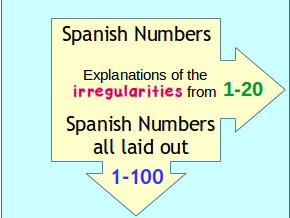The Spanish number system is a game of two halves. Counting in Spanish from 1 to 20 is a bit irregular. There’s no avoiding memorizing all of the individual numbers. However, after the number 20 order takes hold and you can rely on the system to carry you through.
The numbers up to 20 in Spanish
| Numeral | Number in Spanish |
| 1 | uno |
| 2 | dos |
| 3 | tres |
| 4 | cuatro |
| 5 | cinco |
| 6 | seis |
| 7 | siete |
| 8 | ocho |
| 9 | nueve |
| 10 | diez |
| 11 | once |
| 12 | doce |
| 13 | trece |
| 14 | catorce |
| 15 | quince |
| 16 | dieciséis |
| 17 | diecisiete |
| 18 | dieciocho |
| 19 | diecinueve |
| 20 | veinte |
Notice that there is an accent on 16 (dieciséis), but not on 6.

Counting in Spanish 1 – 100
From twenty on the numbers appear more regular and are easier to remember. The one thing to watch is that the twenties have a slightly different structure from all of the later sets. The “y” is missed out between the two words.
| 20 veinte | veinte uno | veinte dos | veinte tres | veinte cuatro | veinte cinco | veinte seis | veinte siete | veinte ocho | veinte nueve |
| 30 treinta | treinta y uno | treinta y dos | treinta y tres | treinta y cuatro | treinta y cinco | treinta y seis | treinta y siete | treinta y ocho | treinta y nueve |
| 40 cuarenta | cuarenta y uno | cuarenta y dos | cuarenta y tres | cuarenta y cuatro | cuarenta y cinco | cuarenta y seis | cuarenta y siete | cuarenta y ocho | cuarenta y nueve |
| 50 cincuenta | cincuenta y uno | cincuenta y dos | cincuenta y tres | cincuenta y cuatro | cincuenta y cinco | cincuenta y seis | cincuenta y siete | cincuenta y ocho | cincuenta y nueve |
| 60 sesenta | sesenta y uno | sesenta y dos | sesenta y tres | sesenta y cuatro | sesenta y cinco | sesenta y seis | sesenta y siete | sesenta y ocho | sesenta y nueve |
| 70 setenta | setenta y uno | setenta y dos | setenta y tres | setenta y cuatro | setenta y cinco | setenta y seis | setenta y siete | setenta y ocho | setenta y nueve |
| 80 ochenta | ochenta y uno | ochenta y dos | ochenta y tres | ochenta y cuatro | ochenta y cinco | ochenta y seis | ochenta y siete | ochenta y ocho | ochenta y nueve |
| 90 noventa | noventa y uno | noventa y dos | noventa y tres | noventa y cuatro | noventa y cinco | noventa y seis | noventa y siete | noventa y ocho | noventa y nueve |
| 100 cien |
Ordinal Numbers in Spanish
Ordinal numbers in Spanish describe the order of items and are crucial for indicating sequences in everyday communication. Here are some common ordinal numbers and their usage:
- First – Primero/Primera
- Masculine singular: “El primer día” (The first day)
- Feminine singular: “La primera vez” (The first time)
- Second – Segundo/Segunda
- Masculine singular: “El segundo intento” (The second attempt)
- Feminine singular: “La segunda calle” (The second street)
- Third – Tercero/Tercera
- Masculine singular: “El tercer piso” (The third floor)
- Feminine singular: “La tercera puerta” (The third door)
For plurals, ordinal numbers match the gender and number of the nouns they modify:
- Masculine plural: “Los primeros estudiantes” (The first students)
- Feminine plural: “Las primeras flores” (The first flowers)
Understanding and using ordinal numbers is essential for providing clarity and structure in descriptions, such as giving directions, ranking items, or discussing dates and events.
Examples of Spanish numbers in use
Numbers crop up in almost every communication context, but they are more common in some situations than in others. If traveling or living in a Spanish speaking country, you are going to need to hear and understand spoken numbers in all sorts of moments. For example:
Transportation: When using public transportation or hiring a taxi, it’s important to be able to understand and use numbers to tell the driver your destination, the number of passengers, or the fare. Example sentence: Un billete sencillo cuesta dos euros. (A single ticket is two euros.)
Shopping: When shopping in Spanish-speaking countries, it’s important to be able to understand and use numbers to count money and make purchases. Example sentence: La camiseta cuesta veinticinco euros. (The shirt costs twenty five euros)
Restaurant: When ordering food in a restaurant, it’s important to be able to understand and use numbers to specify the number of items you want, the table number, and the check amount. Example sentence: Nos gustaría tres cañas. (We would like three beers.)
Phone numbers: When communicating with people in Spanish-speaking countries, it’s important to be able to understand and use numbers to give or receive phone numbers. Example sentence: Mi número de teléfono es 6, veinte cuatro, sesenta y seis, ochenta y dos. (My phone number is 6246682.)
Time and Dates: When making appointments or arranging meeting times, it’s important to be able to understand and use numbers to specify the time and date. Example sentence: ¿Podemos reunirnos a las diez de la mañana el viernes? (Can we meet at 10 am on Friday?).
These real-life situations show the importance of being able to understand and use numbers in Spanish in everyday communication.
Listening practice for Spanish numbers
Here are some ideas for Spanish language audio and video resources that habitually contain a higher than usual use of numbers, so that you can get a lot of practice hearing correct pronunciation and use examples.
- Spanish Radio News Broadcasts – Spanish radio news broadcasts often use numbers to report the latest news and current events.
- Spanish Sports Broadcasts – Spanish sports broadcasts, such as soccer or baseball games, use numbers to report scores and statistics.
- Spanish Financial Podcasts – Spanish financial podcasts often discuss financial market trends, stock prices, and company earnings.
- Spanish Language TV News – Spanish language TV news broadcasts often report on current events and news using numbers. TV news has the added advantage of giving visual context and sometimes studio graphics and charts.
- Spanish Language Cooking Shows – Spanish language cooking shows often use numbers to give precise instructions for recipes. This type of resource can help you practice using numbers in a very specific context.
FAQs on counting and numbers in Spanish
How can I effectively learn and remember Spanish numbers?
Learning and remembering Spanish numbers can be achieved through consistent practice and repetition. Start by memorizing the numbers from 1 to 20, as they are irregular. After that, focus on understanding the patterns for numbers above 20. Utilize flashcards, online exercises, and audio resources to reinforce your knowledge. Regularly practicing counting, listening to numbers, and using them in everyday situations will help you internalize them over time.
How do I handle agreement and gender when using numbers in Spanish?
In Spanish, numbers agree in gender and number with the nouns they modify. When counting objects, the cardinal numbers (1, 2, 3, etc.) agree with the gender of the noun. For example, “one book” is “un libro” (masculine), while “one chair” is “una silla” (feminine). Additionally, when a number is used as an adjective, it agrees in gender and number with the noun it describes. For instance, “dos libros” (two books) and “dos sillas” (two chairs).
How are decimals expressed in Spanish numbers?
In Spanish, decimals are expressed using a comma (“,”) instead of a decimal point. The word “coma” is used to indicate the comma. For example, the number 3.5 would be expressed as “tres coma cinco.” It’s important to note that the word “coma” is used to separate the whole number part from the decimal part. Additionally, when reading decimals, each digit after the comma is pronounced individually. For example, 0.75 would be pronounced as “cero coma setenta y cinco” (zero comma seventy-five).

